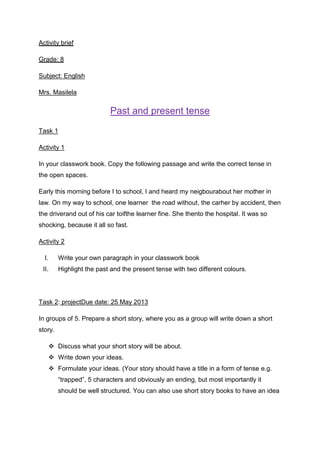
Past and present tense activity
- 1. Activity brief Grade: 8 Subject: English Mrs. Masilela Past and present tense Task 1 Activity 1 In your classwork book. Copy the following passage and write the correct tense in the open spaces. Early this morning before I to school, I and heard my neigbourabout her mother in law. On my way to school, one learner the road without, the carher by accident, then the driverand out of his car toifthe learner fine. She thento the hospital. It was so shocking, because it all so fast. Activity 2 I. Write your own paragraph in your classwork book II. Highlight the past and the present tense with two different colours. Task 2: projectDue date: 25 May 2013 In groups of 5. Prepare a short story, where you as a group will write down a short story. Discuss what your short story will be about. Write down your ideas. Formulate your ideas. (Your story should have a title in a form of tense e.g. “trapped”, 5 characters and obviously an ending, but most importantly it should be well structured. You can also use short story books to have an idea
- 2. on how to write your short story. You can also use dictionaries to check your spelling and you are welcome to use other sources that will help). After writing the story, as a group, highlight the past tense with a green highlighter and the present tense with a blue highlighter. Task 3 In your groups of 5. You will write down the present and the past tense that you have highlighted, on a big chart. Then write the present tense that you highlighted with a blue colour in your short story on the chart and give the past tense of these words, then do the same with the past tense that you highlighted with a green colour and write the present tense of those words. You will then divide those words amongst yourselves and then as a group, each member will do a presentation on the tense that you highlighted in your short stories. Task 4 In the given text underline the words that are in past tense and the present tense. Write those words which you have underlined in your classactivity book. Then write the past tense of the words in the present tense that you have underlined and then write the present tense of those words that are in the past tense.
- 3. Characteristics of authentic activities 1. Authentic activities have real-world relevance- learners go home and find resources to help them with their project. This helps with their vocabulary, in terms of speaking, they will know what tenses to use in a sentence. 2. Authentic activities are ill-defined, requiring students to definetasks and subtasks needed to complete the activity- learners write their own paragraphs and then identify the present and past tense that they found in their paragraphs. 3. Authentic activities comprise complex tasks to be investigated by students over a sustained period of time- I have used it by the learners having enough time to complete their project task, by this I have taken into consideration that they need time to find the needed resources to guide them. 4. Authentic activities provide the opportunity for students to examine the task from different perspectives, using a variety of resources- in the group project, learners can use a variety of resources to help enrich their assignment. The reason why I used this in my activity, because I want the learners to do the right thing and giving them time to do the project will lead to them achieving it. I have used this in my activity, because I want the learners to use the resources as a guide. 5. Authentic activities provide the opportunity to collaborate- I know that when learners work with each other they bring different ideas and they interact and think critical, when sharing information. 6. Authentic activities provide the opportunity to reflect- I used this in my activity, so that the learners combine their information (team dynamics), as a group then give me an oral representation for me to see if they understand the content or the meaning of the project. 9. Authentic activities create polished products valuable in their own right rather than as preparation for something else- I used this characteristic, so that my learners prepare themselves for the group project and have an idea on how they must do, when I give them the project task.
